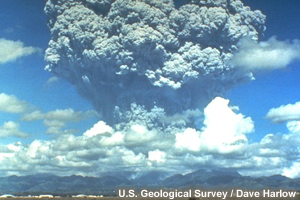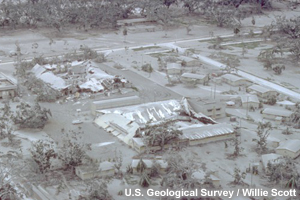Introduction » Mount Pinatubo (1991)

The island of Luzon in the Philippines has thirteen active volcanoes; one of those is Mount Pinatubo (pĭn'ətū'bō). Mount Pinatubo is located approximately 55 mi (90 km) northwest of Manila. In June 1991, it erupted sending large amounts of volcanic ash, sulfur dioxide, and other gases high into the atmosphere. It was the second largest volcanic eruption of the 20th century.
Within two hours of Mount Pinatubo's eruption, volcanic ash and sulfur dioxide rose to an altitude of over 20-25 miles (35-40 km) and the cloud grew to more than 250 miles (400 km) wide. Furthermore, typhoon Yunya was passing 45 miles (75 km) northeast of Mount Pinatubo and brought heavy rain to the area. Volcanic ash mixed with the rain creating a “shower of tephra” (ash and larger particles) that fell across parts of the island of Luzon. The depth of ash deposits ranged from approximately 13 in (33 cm) near the summit to 2 in (5 cm) over a 1500 mi2 (4000 km2) area downwind.

The eruption lasted nine hours and the human impacts were staggering:
- An estimated 800 people died
- Nearly $500M (US) in property and economic damage
- Around 5000 homes were destroyed and another 70,000 were damaged
Nearly half of all casualties were caused by roofs that collapsed under the weight of the ash. Additional deaths and damage were caused by lahars (an Indonesian term) — flows of cement-like mud that formed when the heavy rain mixed with the pyroclastic material. The ongoing monitoring of Mount Pinatubo and subsequent timely warnings averted a larger loss of life.
In addition to the ash, Mount Pinatubo ejected sulfur dioxide gas into the upper atmosphere. The sulfur dioxide mixed with water and hydroxides in the atmosphere to become sulfuric acid aerosol. This aerosol cloud circled the earth in 14-21 days and covered the planet within a year (Mount Hudson, located in southern Chile, erupted from August to October 1991 and contributed a large amount of ash and sulfur dioxide as well). The results of the sulfuric acid aerosol cloud overspreading the globe:
- Reflected a portion of the earth's incoming sunlight back to space and lowered worldwide surface temperatures an average of 1.0° F (0.5° C) in 1992 and 1993.
- Promoted further stratospheric ozone depletion, resulting in a record Antarctic ozone hole.
- Increased scattering of sunlight causing brilliant sunrises and sunsets for years around the globe.
- Longer term damage to aircraft and engines including crazing of acrylic airplane windows, premature fading of polyurethane paint, and accumulation of sulfate deposits on engines.
